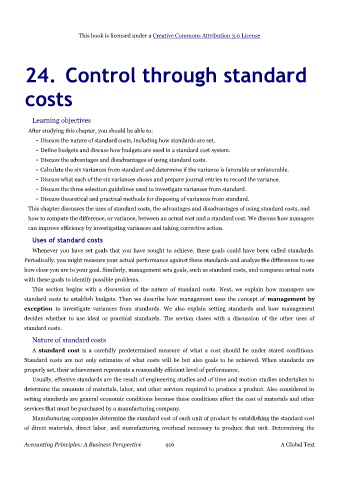Page 915 - Accounting Principles (A Business Perspective)
P. 915
This book is licensed under a Creative Commons Attribution 3.0 License
24. Control through standard
costs
Learning objectives
After studying this chapter, you should be able to:
• Discuss the nature of standard costs, including how standards are set.
• Define budgets and discuss how budgets are used in a standard cost system.
• Discuss the advantages and disadvantages of using standard costs.
• Calculate the six variances from standard and determine if the variance is favorable or unfavorable.
• Discuss what each of the six variances shows and prepare journal entries to record the variance.
• Discuss the three selection guidelines used to investigate variances from standard.
• Discuss theoretical and practical methods for disposing of variances from standard.
This chapter discusses the uses of standard costs, the advantages and disadvantages of using standard costs, and
how to compute the difference, or variance, between an actual cost and a standard cost. We discuss how managers
can improve efficiency by investigating variances and taking corrective action.
Uses of standard costs
Whenever you have set goals that you have sought to achieve, these goals could have been called standards.
Periodically, you might measure your actual performance against these standards and analyze the differences to see
how close you are to your goal. Similarly, management sets goals, such as standard costs, and compares actual costs
with these goals to identify possible problems.
This section begins with a discussion of the nature of standard costs. Next, we explain how managers use
standard costs to establish budgets. Then we describe how management uses the concept of management by
exception to investigate variances from standards. We also explain setting standards and how management
decides whether to use ideal or practical standards. The section closes with a discussion of the other uses of
standard costs.
Nature of standard costs
A standard cost is a carefully predetermined measure of what a cost should be under stated conditions.
Standard costs are not only estimates of what costs will be but also goals to be achieved. When standards are
properly set, their achievement represents a reasonably efficient level of performance.
Usually, effective standards are the result of engineering studies and of time and motion studies undertaken to
determine the amounts of materials, labor, and other services required to produce a product. Also considered in
setting standards are general economic conditions because these conditions affect the cost of materials and other
services that must be purchased by a manufacturing company.
Manufacturing companies determine the standard cost of each unit of product by establishing the standard cost
of direct materials, direct labor, and manufacturing overhead necessary to produce that unit. Determining the
Accounting Principles: A Business Perspective 916 A Global Text

